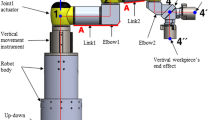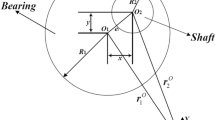Abstract
In combination of the advantages of both parallel mechanisms and compliant mechanisms, a compliant parallel mechanism with two rotational degrees of freedom is designed to meet the requirement of a lightweight and compact pan-tilt platform. Firstly, two commonly-used design methods i.e. direct substitution and Freedom and Constraint Topology are applied to design the configuration of the pan-tilt system, and similarities and differences of the two design alternatives are compared. Then inverse kinematic analysis of the candidate mechanism is implemented by using the pseudo-rigid-body model, and the Jacobian related to its differential kinematics is further derived to help designer realize dynamic analysis of the 8R compliant mechanism. In addition, the mechanism’s maximum stress existing within its workspace is tested by finite element analysis. Finally, a method to determine joint damping of the flexure hinge is presented, which aims at exploring the effect of joint damping on actuator selection and real-time control. To the authors’ knowledge, almost no existing literature concerns with this issue.












Similar content being viewed by others
References
Her I, Midha A (1987) A compliance number concept for compliant mechanisms, and type synthesis. ASME J Mech Trans Autom Des 109(3):348–355
Howell LL (2001) Compliant mechanisms. Wiley, Hoboken
Tlusty J, Ziegert J, Ridgeway S (1999) Fundamental comparison of the use of serial and parallel kinematics for machines tools. CIRP Annal Manuf Technol 48(1):351–356
Wenger P, Gosselin C, Maille B (1999) A comparative study of serial and parallel mechanism topologies for machine tools. In: Proceedings of PKM’99, pp 23–32
Hara A, Sugimoto K (1989) Synthesis of parallel micromanipulators. ASME J Mech Trans Autom Des 111(1):34–39
Yu JJ, Bi SS, Zong GH (2004) A method to evaluate and calculate the mobility of a general compliant parallel manipulator. ASME 2004 international design engineering technical conferences and computers and information in engineering conference, pp 743–748
Bruzzone L, Molfino RM (2006) A novel parallel robot for current microassembly applications. Assem Autom 26(4):299–306
Dong W, Sun LN, Du ZJ (2007) Design of a precision compliant parallel positioner driven by dual piezoelectric actuators. Sens Actuators A 135(1):250–256
Hao GB, Kong XW, Meng Q (2010) Design and modelling of spatial compliant parallel mechanisms for large range of translation. ASME 2010 international design engineering technical conferences and computers and information in engineering conference, pp 329–340
Palpacelli MC, Palmieri G, Callegari M (2012) A redundantly actuated 2-degrees-of-freedom mini pointing device. ASME J Mech Robot 4(3):031012
Hopkins JB, Culpepper ML (2010) Synthesis of multi-degree of freedom, parallel flexure system concepts via Freedom and Constraint Topology (FACT)—part I: principles. Precis Eng 34(2):259–270
Yu JJ, Li SZ, Su HJ, Culpepper ML (2011) Screw theory based methodology for the deterministic type synthesis of flexure mechanisms. ASME J Mech Robot 3(3):031008
Ball RS (1900) A treatise on the theory of screws. Cambridge University Press, Cambridge
Lobontiu N (2003) Compliant mechanisms: design of flexure hinges. CRC Press, Boca Raton
Trease BP, Moon Y, Kota S (2005) Design of large-displacement compliant joints. ASME J Mech Des 127(7):788–798
Ouerfelli M, Kumar V (1994) Optimization of a spherical five-bar parallel drive linkage. ASME J Mech Des 116(1):166–173
Zhang LJ, Niu YW, Li YQ, Huang Z (2006) Analysis of the workspace of 2-DOF spherical 5R parallel manipulator. Robot Autom. In: Proceedings of the 2006 IEEE international conference on robotics and automation, pp 1123–1128
Kong XW (2010) Forward displacement analysis of a 2-DOF RR-RRR-RRR spherical parallel manipulator. Mechatronics and embedded systems and applications (MESA). IEEE/ASME international conference, pp 446–451
Zhang LJ, Niu YW, Huang Z (2006) Analysis of the workspace of spherical 2-dof parallel manipulator with actuation redundancy. Mech Autom. In: Proceedings of the 2006 IEEE international conference, pp 153–158
Sofka J, Skormin V, Nikulin V, Nicholson DJ (2006) Omni-Wrist III-a new generation of pointing devices. Part I. Laser beam steering devices-mathematical modeling. IEEE Trans Aerosp Electron Syst 42(2):718–725
Yu JJ, Dong X, Kong XW, Pei X (2012) Mobility and singularity analysis of a class of two degrees of freedom rotational parallel mechanisms using a visual graphic approach. ASME J Mech Robot 4(4):041006
Lobontiu N, Garcia E, Goldfarb M, Paine JS (2001) Corner-filleted flexure hinges. ASME J Mech Des 123(3):346–352
Smith ST, Badami VG, Dale JS, Xu Y (1997) Elliptical flexure hinges. Rev Sci Instrum 68(3):1474–1483
Wu J, Li TM, Wang JS, Wang LP (2013) Stiffness and natural frequency of a 3-DOF parallel manipulator with consideration of additional leg candidates. Rob Auton Syst 61(8):868–875
Cammarata A, Condorelli D, Sinatra R (2013) An algorithm to study the elastodynamics of parallel kinematic machines with lower kinematic pairs. ASME J Mech Robot 5(1):011004
Bratland M, Haugen B, Rølvåg T (2011) Modal analysis of active flexible multibody systems. Comput Struct 89(9):750–761
Jonker B (1990) A finite element dynamic analysis of flexible manipulators. Int J Robot Res 9(4):59–74
Palmieri G, Martarelli M, Palpacelli MC, Carbonari L (2014) Configuration-dependent modal analysis of a Cartesian parallel kinematics manipulator: numerical modeling and experimental validation. Meccanica 49(4):961–972
Bricout JN, Debus JC, Micheau P (1990) A finite element model for the dynamics of flexible manipulators. Mech Mach Theory 25(1):119–128
Acknowledgments
The authors gratefully acknowledge the financial support of the National Natural Science Foundation of China under Grant No. 51175010 and Ph.D. Programs Foundation of Education of China under Grant No. 20111102130004.
Author information
Authors and Affiliations
Corresponding author
Rights and permissions
About this article
Cite this article
Yu, J., Lu, D. & Hao, G. Design and analysis of a compliant parallel pan-tilt platform. Meccanica 51, 1559–1570 (2016). https://doi.org/10.1007/s11012-015-0116-1
Received:
Accepted:
Published:
Issue Date:
DOI: https://doi.org/10.1007/s11012-015-0116-1




